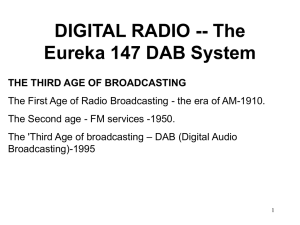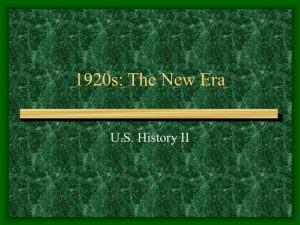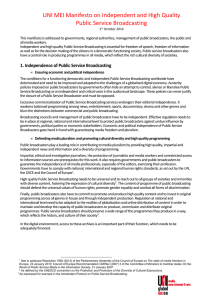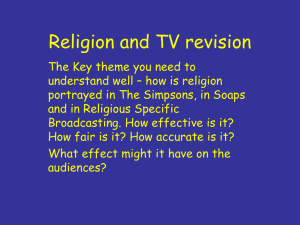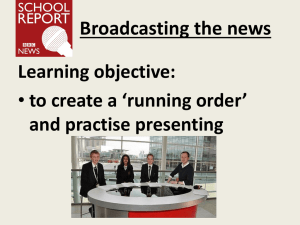here - Digital Radio Mondiale
advertisement
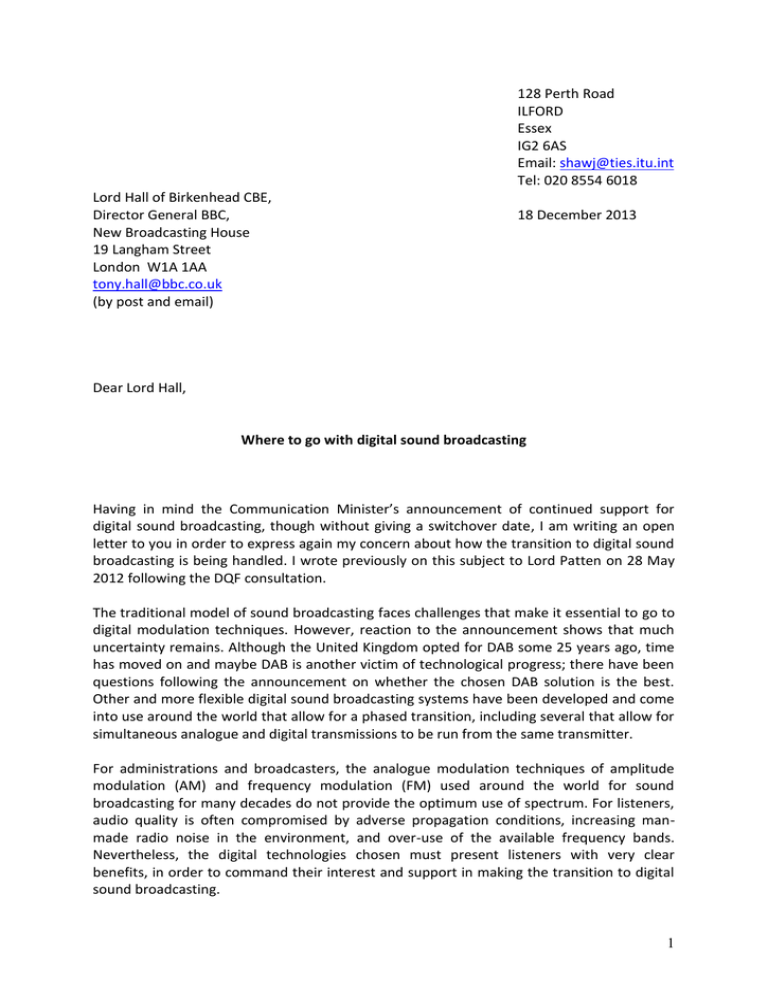
128 Perth Road ILFORD Essex IG2 6AS Email: shawj@ties.itu.int Tel: 020 8554 6018 Lord Hall of Birkenhead CBE, Director General BBC, New Broadcasting House 19 Langham Street London W1A 1AA tony.hall@bbc.co.uk (by post and email) 18 December 2013 Dear Lord Hall, Where to go with digital sound broadcasting Having in mind the Communication Minister’s announcement of continued support for digital sound broadcasting, though without giving a switchover date, I am writing an open letter to you in order to express again my concern about how the transition to digital sound broadcasting is being handled. I wrote previously on this subject to Lord Patten on 28 May 2012 following the DQF consultation. The traditional model of sound broadcasting faces challenges that make it essential to go to digital modulation techniques. However, reaction to the announcement shows that much uncertainty remains. Although the United Kingdom opted for DAB some 25 years ago, time has moved on and maybe DAB is another victim of technological progress; there have been questions following the announcement on whether the chosen DAB solution is the best. Other and more flexible digital sound broadcasting systems have been developed and come into use around the world that allow for a phased transition, including several that allow for simultaneous analogue and digital transmissions to be run from the same transmitter. For administrations and broadcasters, the analogue modulation techniques of amplitude modulation (AM) and frequency modulation (FM) used around the world for sound broadcasting for many decades do not provide the optimum use of spectrum. For listeners, audio quality is often compromised by adverse propagation conditions, increasing manmade radio noise in the environment, and over-use of the available frequency bands. Nevertheless, the digital technologies chosen must present listeners with very clear benefits, in order to command their interest and support in making the transition to digital sound broadcasting. 1 While there is no doubt that the levels of noise and interference from competing broadcasting stations do not make for a satisfactory listening experience in the crowded long and medium wave bands used for AM broadcasting, there are many cases, such as the BBC Radio 4 long wave service on 198 kHz, where the advantages of easy availability of continuous regional or nationwide coverage outweigh the poorer quality. Radio 4 long wave can be received well into Europe, up to around Paris. The advantages of wide area long and medium wave broadcasting have been recognised and reassessed in many countries around the world, including India, Russia, Ukraine, USA, Bangladesh, Taiwan and, Japan. These countries are leading the way on replacing AM services with digital sound broadcasting systems. A particularly attractive consideration is being able to achieve subjective audio quality close to that of FM along with more stable reception over long distances. India is progressing rapidly with replacing its AM broadcasting networks with digital sound broadcasting after settling on the DRM30 transmission mode of the Digital Radio Mondiale (DRM) standard. Russia and Ukraine are also well advanced in implementing the transition to digital sound broadcasting on medium wave. The involvement of these countries will ensure that low cost DRM30 receivers become widely available. The Indian state broadcaster AIR has put out a tender for DRM receivers and 5 major manufacturers have already responded. The experience with DRM30 implementations to date is that there are major savings in transmission power and electricity costs – down to between half or a quarter of conventional AM transmitter consumption – coupled with audio quality close to FM and the means to operate in stereo. This lead could be followed here by replacing the BBC R4 long wave transmitter with a solid state DRM30 capable transmitter, as has been done in Denmark with the Kalundborg station on 243 kHz. The DRM family of coding and transmission modes for digital sound broadcasting was developed by a consortium of European broadcasters (with BBC one of its founding fathers), research bodies and standards developing organisations. Development started with the DRM30 transmission mode as a replacement for AM broadcasting in the long, medium and short wave bands. DRM30 is one of several digital sound broadcasting systems recommended by the International Telecommunication Union (ITU)1, but is the only one recommended for use in all the broadcasting bands below 30 MHz. For the VHF broadcasting bands (above 30 MHz), the DRM Consortium has also developed the DRM+ transmission mode of the DRM standard. Following extensive trials and evaluation, DRM+ has also been recommended by the ITU2 . Another ITU recommended system, HD Radio3, has been authorized for implementation in the United States, Mexico, Panama and the Philippines. The first authorization was issued in the United States in 2004. As of October 2013, there are approximately 2,200 AM and FM stations broadcasting digitally in the United States. Those stations also transmit more than 1,200 digital-only multicast programming channels. HD receivers for home and car use are widely available. 1 The DRM30 system is described in Annex 1 to ITU-R Recommendation BS.1514. DRM+ is classified as “Digital system G” in ITU-R Recommendation BS.1114. 3 The medium wave and VHF variants of HD Radio are described in Annex 2 to ITU-R Recommendation BS.1514 and under Digital System “C” in ITU-R Recommendation BS.1114, respectively. 2 2 The HD and DRM radio systems were developed specifically to allow for a phased transition to digital sound broadcasting over several years, and can support simultaneous analogue and digital coverage from the same transmitter. However, there would be difficulty in adapting the HD Radio system for use in the crowded spectrum found in Europe, where tightly controlled Plans administered by the ITU apply to transmitter locations and frequency assignments for broadcasting in the long, medium and VHF broadcasting bands. A substitution scheme has already been authorised by the ITU for converting long and medium wave AM transmissions into DRM30 transmissions. DRM30 therefore has the potential to revitalise the bands originally used for AM broadcasting. Broadcasters providing international, national and regional services have an excellent opportunity to cut costs, simplify their operations and attract new audiences to high quality programming. It therefore seems that a strong case can be put to the public to make a rapid transition to digital sound broadcasting in the long and medium wave bands using the DRM30 mode of the DRM standard. A clear lead from the BBC and government in favour of making a rapid transition to digital sound broadcasting in the long and medium wave bands would bring very tangible benefits to European broadcasters and listeners. A transition to DRM30 would also offer a convenient solution to the uncertainty surrounding the continued operation of the Radio 4 long wave service. Matters are less clear cut in respect of ceasing FM services; listeners have well-founded concerns on why FM services need to be switched off and why DAB is offered as the only solution. Listeners could benefit more in terms of diversity of programming, coverage, quality and convenience if the replacement digital sound broadcasting system offered more flexibility than DAB. Moreover, a later development of the DAB system, the DAB+ standard (currently being introduced in Germany and Switzerland), could not be offered in the United Kingdom without replacing the present DAB transmitter infrastructure and receiver base. With hindsight we can see that concentrating on developing digital sound broadcasting systems that can offer the route of a phased replacement of the wide variety of FM services available – national, regional, local and community – would have had advantages, especially as regards helping to allay many of the concerns felt by listeners and broadcasters. Uppermost is the feeling among listeners that they are being forced into a one size fits all DAB multiplex box. Also, the cost of joining multiplexes may deter many smaller scale broadcasters if they find that the multiplex coverage is a poor match to their listener base and to advertisers’ expectations. If smaller commercial or community based stations are faced with a mismatched or absent transmission option, or unaffordable transition costs, then a vital mix of diverse content is put at risk. Such stations will certainly be placed at a disadvantage to the larger broadcasters, for whom the DAB system was designed. Development of the DAB system started some 25 years ago as the Eureka 147 project under the technical direction of the European Broadcasting Union and with the active support of the major European broadcasters. The multiplex delivery system is indeed well suited to the needs of large scale broadcasters, where being able to deliver a number of programmes 3 across the same coverage area is a distinct advantage – indeed this was one of the main design objectives. However, many independent commercial and community-based broadcast operators fear being severely disadvantaged due to an absence of transmission capacity or because of unaffordable transition costs. This situation has come about because the DAB system was designed in a top-down manner in order fulfil the needs of the large broadcasting organisations in Europe rather than with the listening habits and preferences of ordinary people in mind. DAB offers a large multiplex solution to radio listening similar to digital television. Yet people generally settle on a few favourite radio stations and do not constantly zap around the multiplexes, as with television viewing, until an interesting scene comes up. People do want a diversity of radio programming available but generally stick to a few favourites suited to their tastes and location. It is a paradox that by organising radio programming into large multiplexes listener choice is reduced to a choice between the public and larger commercial broadcasters. Fortunately, with the passage of time, there is now a simple European solution to overcoming the limitations of the DAB system in the form of DRM+, the latest development of the DRM family of coding and transmission schemes. The DRM+ transmission mode was developed as a replacement for analogue sound broadcasting in the VHF broadcasting bands, so as to be compatible with the stringent band planning constraints in Europe. Initially, DRM+ was only intended to replace FM broadcasting in VHF Band II (87.5-108 MHz). However, the success of the DRM+ trials in Band II (with successful full scale trials in Edinburgh, Rome and elsewhere) has led to consideration of using DRM+ to provide new broadcasting opportunities in Band I (47-72 MHz) and Band III (174-230 MHz). Most importantly for organizing a transition to digital sound broadcasting, DRM+ allows for a phased one-for-one substitution of FM stations by DRM+ capable stations that can duplicate the original coverage area, whether large or small – a feature that is absent from the DAB transition route. This is an essential consideration when it comes to evaluating options for a switchover to digital sound broadcasting, especially as regards replacing FM, which has come to be the de facto global standard for radio transmission. We should avoid hyperbole when informing the public about the benefits that can be gained from digital sound broadcasting and take care to address the concerns of those who see only a forced and premature wholesale switch to DAB from FM broadcasting. But now we have the opportunity to make a fresh, pragmatic and holistic assessment of the options for a transition to digital sound broadcasting. The public needs to be satisfied that scrapping a bin full of radios around every house will outweigh the cost and inconvenience of making the change to digital sound broadcasting. What was wrong with all that equipment? We should therefore take the present opportunity to consider evidence and to carry out a full cost benefit and impact analysis on any switchover scheme. Previous consultations seem to have been dominated by those who shout loudest. Moreover, the eventual solution must encompass broadcasters at all levels and genres, from BBC national services to small scale Community Radio. The DRM30 and DRM+ systems incorporate the technical means to make a phased transition to digital sound broadcasting, well suited to the broadcasting environment in the United Kingdom, without the need for a D-day style big bang, and would 4 also allow the link with established service areas to be retained. Then, as the rolling transition proceeds, the further benefits of digital transmission can be brought on stream. For example, DRM+ can offer mini-multiplexes in the VHF bands to serve local needs, together with a range of associated or standalone data services, giving broadcasters additional opportunities to serve their audiences A pause for reconsideration and reassessment by the BBC of objectives, alternatives and overall strategy could provide a win-win outcome for broadcasters and listeners together. Yours sincerely John Shaw Chairman of the ITU-R Working Party 6A Rapporteur Group on the transition to digital sound broadcasting. 5

